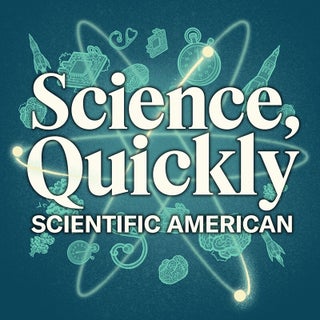This podcast was produced for The Kavli Prize by Scientific American Custom Media, a division separate from the magazine’s board of editors.
Megan Hall: How do we feel the difference between a light breeze and a pinch? To find out, Scientific American Custom Media, in partnership with The Kavli Prize, sat down with Professor Ardem Patapoutian. He shared The Kavli Prize in Neuroscience in 2020 for answering this basic question.
Ardem says, until recently, no one really understood how our sense of touch works.
Ardem Patapoutian: Decades ago, we figured out how we see and then how we smell and taste. How we sensed touch was a big mystery.
Hall: Why was touch so difficult to understand? Ardem says no one knew how the body turned a physical sensation like a squeeze on your arm into a message that cells could understand.
Patapoutian: I always compare this in a dark room that you don’t know what’s going on inside. You need to find the door handle so that you can open the door, turn on some lights and find out what’s inside.
Hall: After a series of painstaking experiments, Ardem and his colleagues found that doorknob—a special type of proteins they named the Piezos.
Patapoutian: These are fascinating molecules that do one thing, and that is they let ions go from outside the cell to inside the cell, or vice versa.
Hall: The body has lots of these ion channels that open and close to pass messages to our cells. But almost all of them move in response to some sort of chemical change.
What was different about the Piezos was that they responded to physical pressure. No one had seen anything like this before.
Patapoutian: Once you have these proteins and ion channels, then lots of things are available to scientists to study them. You can get rid of them, see what happens without them. We can activate them and see what happens. You can see where they are expressed in the body and what they do.
Hall: So that’s what Ardem and his colleagues continued to do. They soon discovered that one of the Piezos, Piezo2, doesn’t just sense pressure, it also helps us keep our balance.
Patapoutian: So, this is how I can close my eyes and touch my nose. This is why you're coordinated. This is why you can walk. Without Piezo2, that doesn’t function at all.
Hall: Ardem’s team also learned that Piezos play a role in controlling bone density, preventing malaria and even telling us when it’s time to go to the bathroom.
Patapoutian: The doorknob analogy has become very interesting for us, because it’s kind of taken us into rooms that we didn’t even know they existed.
Hall: One new question he’s excited about? Whether Piezos tell us when it’s time to stop eating.
Patapoutian: So, for example, if you eat a large meal, and we all do this, we regret it later. The stomach feels very full, right? So that seems like a very mechanical signal coming from the stomach.
If the Piezos are the sensors for this, which is a hypothesis that we’re asking, then we can go in and ask the question: How much does the mechanical stretch contribute to how much you eat, when you eat? So, here’s a perfect example of when we were looking for the touch sensor. We never thought that this will take us in these kinds of directions.
Hall: All of these directions also have practical implications. Doctors could use knowledge about Piezos to treat all sorts of things, including obesity, osteoporosis and chronic pain—specifically, a condition that makes even gentle touches hurt.
Patapoutian: Easiest example of this is sunburn. When you have a sunburn, just a touch on your shoulder becomes painful. Sunburn is not something we need to treat clinically. But people who suffer from neuropathic pain can’t wear a shirt because it’s too painful.
Hall: Ardem says Piezos might also hold the key to addressing other types of pain. He says most medications, like opioids, attack the perception of pain in the nervous system.
Patapoutian: Opioids gets into the brain and does lots of things. So, all the addiction and all the other side effects are because it is acting on the brain.
Hall: But what if you could use some sort of Piezos blocker to address pain where it starts?
Patapoutian: The idea of blocking pain at the source has the great advantage of not having side effects.
Hall: Ardem says scientists could also use the gene-editing technology known as CRISPR to treat genetic mutations in how Piezos are built.
Patapoutian: I don’t want to overstate it, of course, because it’s very early days, and the scientific community is being very careful in how fast these kinds of technologies are explored. But at the same time, it is indeed very exciting promise that for genetic disorders that you know what the mutation is, there is the possibility of going and correcting them.
Hall: These fixes are still years away from being available. But Ardem says the possibilities are thrilling.
Patapoutian: This is just the beginning. There's just so much more to discover, so I think the future is also very exciting.
Hall: He looks forward to opening new doors and bringing light to the mysteries of how our bodies work.
Ardem Patapoutian is a professor at the Scripps Research Institute and an investigator for the Howard Hughes Medical Institute. In 2020, he shared The Kavil Prize in Neuroscience with David Julius from the University of California, San Francisco, who discovered a family of receptors that allow us to sense temperature.
The Kavli Prize recognizes scientists for pioneering advances in the fields of astrophysics, nanoscience and neuroscience. The Kavli Prize is a partnership among The Norwegian Academy of Science and Letters, The Norwegian Ministry of Education and Research, and the US-based Kavli Foundation.
This work was produced by Scientific American Custom Media and made possible through the support of The Kavli Prize.

